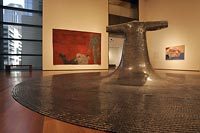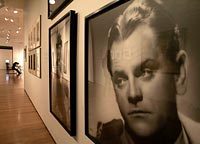SAM's expanding universe

Ride the escalators up to Seattle Art Museum's expansive new galleries and you'll glimpse an Andy Warhol portrait of Elvis, an early American portrait by John Singleton Copley, a display of African masks, and Constantin Brancusi's modern-art icon, "Bird in Space."
The museum's vast array of art from different eras and regions once led SAM to bill itself as "a collection of collections." Now, with a spacious new addition and free-flowing galleries, the trick is to make those collections compatible — so that when you step off the escalator, you'll find more than an art smorgasbord. As curators grapple to find links among disparate cultures and traditions brushing against each other, the buzzwords that keep coming up are "bridging" and "thresholds."
After nearly a year-and-a-half with its main venue closed for expansion, the museum is ready to unveil a much bigger and brighter building — and a lot of new art: SAM recently announced gifts to the collection valued at more than $1 billion. Of nearly 1,000 new acquisitions, about 225 will be on view for the opening.
There are new displays, too: a dramatic Porcelain Room with a ceiling fresco by Italian Rococo painter Giovanni Battista Tiepolo; a fully reconstructed 400-year-old wooden room from Northern Italy; and a new gallery dedicated to the life and work of the late painters Jacob Lawrence and Gwendolyn Knight. Also for the first time, SAM boasts permanent exhibition spaces for textile art, glass and Australian aboriginal painting.
For the opening, SAM turns the spotlight on its own extensive holdings. Some beloved icons such as the 17th-century Japanese Crow screen and Do-Ho Suh's dazzling sculpture "Some/One" will be back on view along with recent gifts and acquisitions — among them Morris Graves' 1943 "Bird in the Night"; Copley's 18th-century portrait of "Dr. Silvester Gardiner" and Bartolomé Esteban Murillo's 17th-century "Saint Augustine in Ecstasy."
In the old Robert Venturi building, visitors often headed straight to whatever blockbuster show was promoted in the second floor special exhibition galleries, skipping over the permanent collections tucked away in their own parts of the building. Now, a more open floor plan leads visitors up escalators and through the collections before finally depositing them at the fourth floor special exhibition space.
Organizing principles
Entering the museum, one of the first things you'll notice is a lot more natural light.
"We wanted a building with light," said chief curator Chiyo Ishikawa. "It's a much more open experience of art." But the sunlight filtering in through a bank of west windows (outfitted with layers of scrims and screening) also restricts the curators. The first artwork you'll encounter near the escalators along the west and north windows is there for a pragmatic reason: It can take more sunlight than fragile works on paper, photography or textiles. That's where you'll find African art, glass, and Ancient Mediterranean and Islamic art, as well as modern and contemporary art in light-resistant media.
Beyond the immediate concern with ultraviolet levels, three main principles guided the curators' planning process, Ishikawa said: "to address cultural contexts, show the best of what we have, and bridge between past and present, between cultures. ... It's something our collection does very well: a series of overlaps."
Modern, American
and Northwest art
In the modern-art galleries, curator Michael Darling focused on the collection's strengths in galleries featuring Pop art, Minimalism and Abstract Expressionism; much of the work traces back to the long-term patronage of Virginia and Bagley Wright, and the late Anne Gerber.
A double-height gallery at the northwest corner allows space for some of the museum's largest paintings and sculptures: Do-Ho Suh's chain-mail robe of military dog tags "Some/One" (7 by 10 ½ feet); Katharina Fritsch's giant rodent and sleeping human "Mann und Maus" (7 ½ feet tall); Leon Golub's acrylic on canvas "White Squad II" (about 10 by 13 feet); and Anselm Kiefer's 9-by-16-foot mixed-media painting "Die Welle (Wave)."
A selection of mixed-media works by German conceptualist Joseph Beuys, several donated by Gerber, points to her progressive taste. "Most of the really far-out things came from her," Darling noted.
For a narrow gallery of photography, Darling chose people pictures, by shooters as varied as Diane Arbus, Edward Curtis, August Sander, Robert Frank and Hollywood portraitist George Hurrell.
The American art galleries are front and center in the new museum. SAM is aiming to beef up its holdings by attracting gifts from important local collections. Curator Patti Junker makes no bones about the fact that collection-building is her top priority. Hoping that they will eventually be donated to SAM, she has borrowed a number of works for the opening installation, including paintings by George Bellows, William Merritt Chase, Childe Hassam, and John Singer Sargent. Junker gives pride of place to the newly acquired Copley portrait, which she calls the "linchpin" of the American-art collection.
Junker also assembled an opening show for the small Northwest art gallery, focused on early works by Mark Tobey, Morris Graves and Guy Anderson. Generally, Kenneth Callahan has been presented with those artists as one of the Northwest's "big four" painters, but Junker says her take on regional art is different: "I'm more interested in them as individuals than as a group."
Native American,
African and European art
Besides more natural light in the galleries, you'll also notice more white walls.
It signals a shift in the way Native American and African art is displayed, says lead exhibition designer Michael McCafferty. "We did that deliberately to shake the stereotypes of the 'dark continent' and the rainforest. We wanted to show these collections in a modern context again ... to present everything as fresh and living, like something done today."
That suits Native American art curator Barbara Brotherton just fine. She views the collection as fine art, not anthropological material, and aims to make visitors aware of the individual artists. "In their own time ... they had reputations, people recognized their work, they developed their own styles that artists who came after them emulated," Brotherton said. "That's something the general population doesn't know about." Brotherton also freely mixes contemporary and historical artworks, showing the lineage of artist-families and highlighting objects that speak across generations.
African art curator Pam McClusky points out the cultural interplay between contemporary artist Yinka Shonibare's "Nuclear Family" installation — a family of headless mannequins done-up in Victorian-style clothing that's sewn from African-patterned fabrics exported from Europe — and prints by the 18th-century British satirist William Hogarth hung in the same gallery.
"Yinka cites Hogarth as one of his inspiration points for his use of parody," McClusky says. "It's kind of reversing the role you usually see in museums, of a great European referring to African art — like Picasso looking at African masks. ... So, here we have an Anglo-Nigerian referencing a European."
In the European galleries, curator Ishikawa and designer McCafferty chose a soft lavender gray for the walls, as "a nod to their period," McCafferty said. New acquisitions on display include the Murillo "Saint Augustine," a promised gift of Richard and Betty Hedreen, and Vincent Sellaer's 1540 oil "Leda and the Swan and Her Children," given to the museum in honor of Ishikawa by Hester Diamond.
Special exhibition
Now, on to the debut of the new fourth-floor special-exhibitions galleries, decked out in a sweeping display of gratitude to SAM patrons. The opening exhibition, "SAM at 75: Building a Collection for Seattle" is just what the name implies: The cream of the artworks recently gifted in honor of the museum's 75th year and its new building. The list is impressive.
From collectors Jon and Mary Shirley come two major sculptures: Brancusi's bronze "Bird in Space," part of a groundbreaking series by the acclaimed modernist sculptor, and Alberto Giacometti's 1951 bronze "The Dog." (Other examples of Brancusi's "Bird" can be found at the Metropolitan Museum and the Museum of Modern Art in New York.)
The Shirleys also gave Jackson Pollock's 1949 oil painting "Number 20," Mark Rothko's 1956 "Orange on Red" and Jasper Johns' 1967 oil-and-collage "Harlem Light."
Many gifts from the extensive Virginia and Bagley Wright collection are already familiar to museumgoers: An exhibition at SAM in 1999 spotlighted much of the collection and the couple have displayed some over the years at their private gallery, The Wright Exhibition Space. Among the works on display from the Wrights are paintings by Philip Guston, Barnett Newman, Eva Hesse, Franz Kline, Ellsworth Kelly, Jasper Johns and Sigmar Polke and sculpture by Donald Judd, Maurizio Cattelan, David Smith, John Chamberlain and Claes Oldenburg.
For the opening of the new special-exhibitions gallery, SAM is flaunting the generosity of its patrons as much as the prestigious artworks. As you admire the new acquisitions, you can check the labels to see who gave what: Barney Ebsworth, Gladys and Sam Rubinstein, Jeffrey and Susan Brotman, Herman and Faye Sarkowsky ... the list goes on.
By the time you reach the end of "SAM at 75" you will no doubt get the picture. Seattle Art Museum is a much bigger and more comprehensive museum than it was just a few years ago.
Sheila Farr: sfarr@seattletimes.com


Reopening soon
Seattle Art Museum OPENING WEEKEND MARATHON: The museum will be open from 10 a.m. Saturday through 9 p.m. Sunday. Admission is free but timed entry tickets are required and will be available on site beginning Saturday. Admission will also be free at Seattle Asian Art Museum at Volunteer Park.
Free shuttles will run among SAM's three sites leaving from Second Avenue and University Street from 10 a.m. — 5 p.m. Saturday and Sunday. Shuttles will also run from YMCA locations on E. Madison, in Shoreline and in Burien.
Regular hours AND INFO: 10 a.m.-5 p.m. Tuesdays-Sundays, extended hours until 9 p.m. Thursdays and Fridays and until midnight the first Thursday of each month through Sept. 9, 1300 First Ave., Seattle; $13 adults, $10 seniors, $7 students, Free to members and children 12 and younger. Free the first Thursday of each month, except when special exhibition surcharges apply. (206-654-3100 or www.seattleartmuseum.org)
Parking: Spots are available in the WaMu Parking Garage. Entrance is below the SAM building on Union Street between First and Second avenues. Hours: 6 a.m.-midnight Mondays-Fridays, 9 a.m.-midnight Saturdays, and 10 a.m.-10 p.m. Sundays. For info: 206-264-8444.
This is an ADA-accessible garage; it has an elevator that will leave you around the corner from the museum's main entrance. Starting May 8 it will let you off inside the museum. Drop-off areas for visitors with special needs, other paid parking lots and metered parking are available near the Seattle Art Museum.